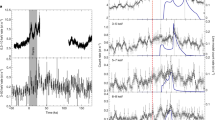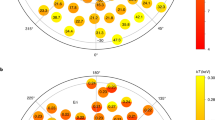Abstract
AN application of Merton and Nicholson' form of the wedge method has been made to the study of the intensity distribution in typical stellar spectra. In the late type spectra (including the sun), which are sufficiently bright at the red end, the energy curves give a marked depression from 0.50–0.67µ—a result not obtained by other observers. As the spectrum of the carbon arc, assumed to radiate as a black body at a temperature of 3750° Abs., is used to remove the colour curve of the plate, a possible cause of this depression, which is common to all stellar spectra that have been observed in the red, would lie in an intensity distribution in the carbon arc differing from that assumed.
This is a preview of subscription content, access via your institution
Access options
Subscribe to this journal
Receive 51 print issues and online access
$199.00 per year
only $3.90 per issue
Buy this article
- Purchase on Springer Link
- Instant access to full article PDF
Prices may be subject to local taxes which are calculated during checkout
Similar content being viewed by others
Author information
Authors and Affiliations
Rights and permissions
About this article
Cite this article
PLASKETT, H. Radiation from the Carbon Arc. Nature 107, 648–649 (1921). https://doi.org/10.1038/107648a0
Issue Date:
DOI: https://doi.org/10.1038/107648a0
Comments
By submitting a comment you agree to abide by our Terms and Community Guidelines. If you find something abusive or that does not comply with our terms or guidelines please flag it as inappropriate.



